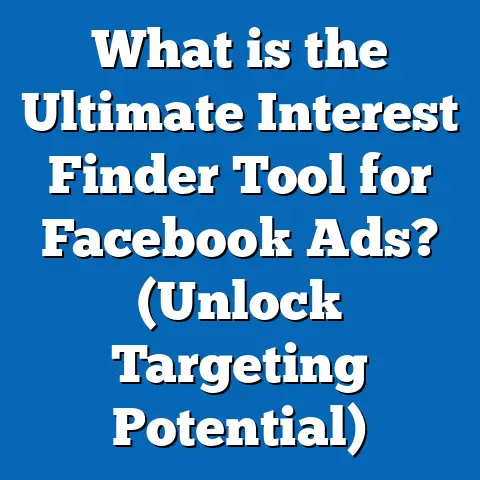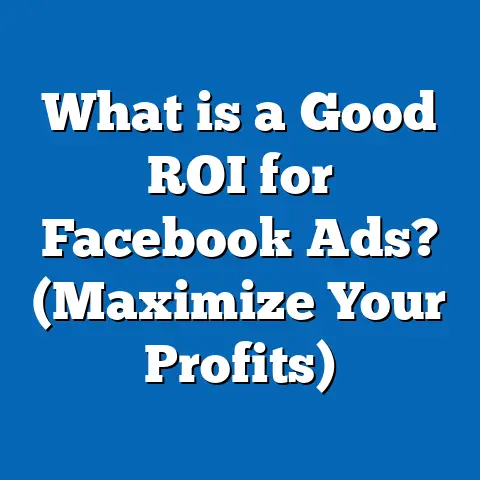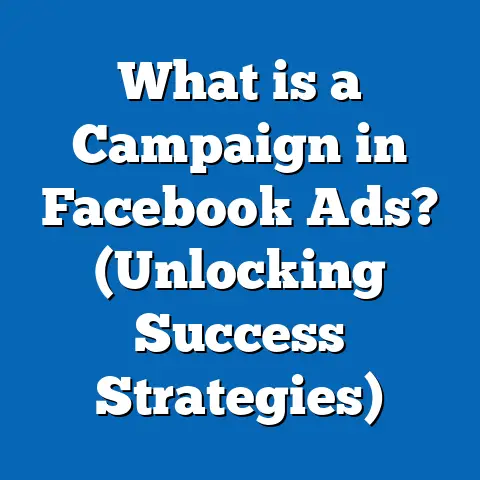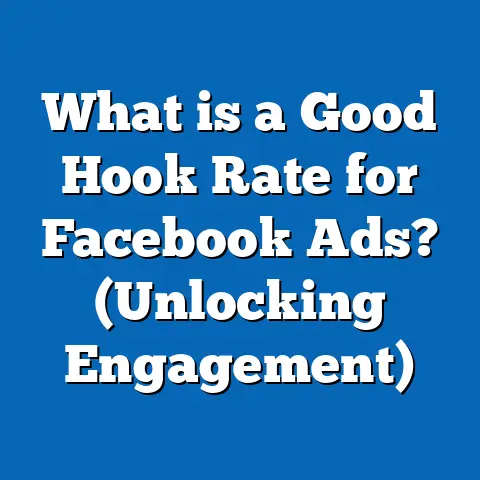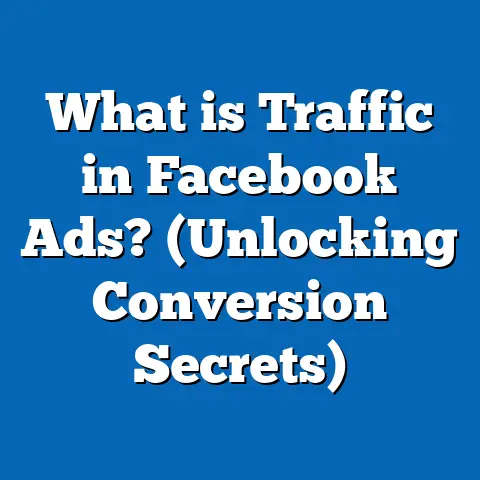What is Social Proof in Facebook Ads? (Boost Your Conversions)
What is Social Proof in Facebook Ads? (Boost Your Conversions)
Introduction: The Power of Social Proof in Pop Culture and Marketing
Imagine a scene from any popular TV show or movie where a new restaurant opens in town, and suddenly there’s a long line outside. People are curious but also feel reassured by the crowd waiting—it signals that the food must be good. This phenomenon is social proof in action: people rely on the behavior of others to guide their own decisions.
Social proof isn’t just a pop culture trope; it’s one of the most powerful psychological triggers marketers use to influence consumer behavior online. On Facebook—the largest social media platform with nearly 3 billion active users—leveraging social proof in ads can transform a passive scroll into an active purchase.
Understanding Social Proof in Facebook Ads
What is Social Proof?
Social proof is a concept rooted in psychology, referring to the tendency of individuals to mirror the actions of others when making decisions. When people see others endorsing or using a product, they interpret it as a sign of quality or popularity.
On Facebook, social proof appears in multiple forms:
- Customer Reviews: Written or video testimonials from past buyers.
- Engagement Metrics: Likes, comments, and shares visible on ads.
- Endorsements: Influencers or experts recommending your products.
- User-Generated Content (UGC): Photos or videos shared by customers.
- Social Counts: Numbers like “10,000+ purchases” or “5-star rating.”
These elements help overcome skepticism by providing external validation.
Why Social Proof Matters in Facebook Advertising
Facebook’s advertising environment is unique because it combines targeting precision with social interaction. Users scroll through content infused with friends’ activities and opinions. Ads that incorporate social proof tap into this dynamic, making them appear more trustworthy and relevant.
Benefits of social proof in Facebook ads:
- Boosts credibility: Seeing others endorse your brand builds trust.
- Improves engagement: Socially validated ads get more likes, comments, and shares.
- Enhances conversions: Consumers are more likely to buy after seeing proof that others did.
- Lowers acquisition costs: Higher engagement and trust reduce cost per conversion.
Data-Backed Insights: The Science Behind Social Proof
- A Nielsen report confirms that 92% of consumers trust recommendations from friends and family over any other advertising form.
- BrightLocal’s Local Consumer Review Survey reveals that 88% of people trust online reviews as much as personal recommendations.
- According to Sprout Social, posts featuring user-generated content receive 28% more engagement than brand-generated content.
- Research published in the Journal of Marketing Research found that products with positive reviews on social media experience a up to 20% increase in sales.
These numbers underscore how social proof can influence buying decisions and why it is essential for Facebook marketers to integrate it strategically.
The Psychology Behind Social Proof: Why It Works
The Science of Influence: Understanding Human Behavior
Humans have evolved to rely on social cues for safety and decision-making. When uncertain about what to do, people instinctively look at the behavior of others—this is known as informational social influence. It reduces cognitive load and perceived risk.
Robert Cialdini’s famous book Influence highlights social proof as one of six key principles that drive compliance and persuasion. When people see others endorsing a product or service, they feel more comfortable making the same choice.
Types of Social Proof Relevant to Facebook Ads
- Expert Social Proof: Endorsements from specialists or well-known industry figures build authority.
- Celebrity Social Proof: Celebrity endorsements add prestige and can attract attention.
- User Social Proof: Customer reviews, testimonials, and user-generated content increase relatability.
- Wisdom of the Crowd: Showing large numbers of customers or purchases signals popularity.
- Friends’ Social Proof: Facebook’s unique feature where users see what friends have liked or purchased adds personalized validation.
Each type appeals differently depending on audience demographics and campaign goals.
Implementing Social Proof in Facebook Ads: Practical Strategies
1. Incorporate Customer Reviews and Testimonials
Reviews are among the most trusted forms of social proof. Use direct quotes from satisfied customers in your ads—both text-based and video formats work well.
- Add star ratings prominently.
- Include before-and-after photos where relevant.
- Use authentic stories that highlight specific benefits.
Example: A skincare brand running carousel ads displaying real user testimonials along with transformation images boosted conversions by 35%, according to their internal analytics.
2. Highlight Engagement Metrics on Your Ads
Facebook shows likes, comments, and shares on ads which act as social proof signals.
- Design your ads to encourage interaction—ask questions or run polls.
- Use popular posts with high engagement as ad creatives.
Ads with visible social activity tend to gain further organic reach through Facebook’s algorithm, creating a snowball effect.
3. Leverage Influencer Partnerships for Credibility
Influencers command trust within their communities. Collaborating with micro-influencers (followers between 10k–100k) often yields higher engagement than celebrities due to perceived authenticity.
- Feature influencer endorsements in video ads or static creatives.
- Use influencer-generated content directly in your campaigns.
A fitness apparel brand working with influencers saw a 25% increase in CTR after integrating influencer testimonials into their ads.
4. Showcase User-Generated Content (UGC)
UGC is valuable because it provides real-world proof without seeming overly promotional.
- Encourage customers to tag your brand on Facebook or Instagram.
- Curate UGC into ad creatives showing real people using your product.
Brands targeting younger audiences find UGC particularly effective due to its authentic feel.
5. Utilize Social Proof Tools and Plugins
Integrate apps like Fomo, Proof, or TrustPulse that dynamically show live purchase notifications or recent signups on your landing pages linked from Facebook ads.
Facebook’s native social features such as “Page Likes” and “Recommendations” also serve as built-in social proof mechanisms within the platform.
Advanced Techniques: Optimizing Social Proof for Maximum Impact
Dynamic Social Proof for Audience Segmentation
Customize social proof types based on where users are in the buyer journey:
- Cold Audiences: Use expert or celebrity endorsements to build initial trust.
- Warm Audiences: Show user reviews and testimonials to enhance consideration.
- Retargeted Audiences: Emphasize “popular choice” messaging or show friends’ actions to push for conversion.
Personalized social proof messaging resonates better and drives higher ROI.
A/B Testing Different Formats of Social Proof
Test various social proof strategies such as:
- Text reviews versus video testimonials
- Highlighting engagement numbers versus customer count
- Influencer endorsements versus UGC
Use Facebook Ads Manager split testing tools to analyze which combination best improves key metrics like CTR, conversion rate, and ROAS.
Combining Social Proof With Scarcity and Urgency
Social proof combined with urgency nudges users toward immediate action:
“Join 5,000+ happy customers who bought during our limited-time flash sale!”
This tactic leverages conformity bias alongside fear of missing out (FOMO) for powerful conversion lifts.
Case Studies: Real Results Using Social Proof in Facebook Ads
Case Study 1: E-commerce Brand Increases Sales by 40%
A fashion retailer incorporated customer reviews and UGC into carousel ads. They pinned top-rated reviews in ad captions and used real customer photos alongside product images.
Results:
- 40% increase in sales
- 20% decrease in cost per acquisition (CPA)
- 15% rise in repeat purchases
The authentic representation of customer satisfaction drove confidence among new buyers.
Case Study 2: SaaS Company Enhances Lead Quality with Expert Endorsements
A software company used video testimonials from industry experts inside lead generation ads targeting B2B clients.
Results:
- 30% improvement in lead quality
- 50% higher click-through rate (CTR)
- Increased engagement with related educational content
Expert validation helped overcome buyer hesitation typical of high-investment B2B solutions.
Case Study 3: Health & Wellness Brand Boosts UGC Engagement by 60%
A supplement company launched a UGC campaign encouraging customers to share their success stories on Facebook with branded hashtags.
They ran ads featuring these stories directly sourced from users’ posts.
Results:
- 60% increase in ad engagement
- Enhanced brand loyalty within community
- Organic referral traffic spike
Users trusted peer experiences more than traditional advertising claims.
Comparing Social Proof on Facebook vs Other Platforms
Facebook vs Instagram
While both platforms thrive on social interaction:
- Facebook offers richer formats for detailed reviews and friend recommendations visible directly on ads.
- Instagram relies heavily on influencer partnerships and visual storytelling through Stories, Reels, and posts for social proof impact.
Facebook’s algorithm also shows friends’ actions more prominently, increasing personalized validation.
Facebook vs Google Ads
Google Ads focus on intent-driven search queries but lack an embedded social environment where peer validation is visible during ad exposure.
Facebook’s interactive feed allows immediate display of likes, comments, shares, and friend activity—boosting credibility during awareness and consideration stages significantly.
Latest Trends in Social Proof for Facebook Advertising
Augmented Reality (AR) Integration
Brands use AR filters that allow users to virtually try products (e.g., sunglasses, makeup) while displaying real-time reviews or star ratings within the experience.
AR-driven ads combine immersive tech with social proof for stronger engagement.
AI-Powered Personalization
Advanced AI analyzes user behavior patterns to serve dynamically tailored social proof based on interests and past interactions—showing the most relevant testimonials or endorsements automatically within ads.
This personalization improves resonance and conversion likelihood.
Rise of Micro-Influencers
Micro-influencers provide niche credibility and higher engagement rates than mega-celebrities. Brands increasingly partner with multiple micro-influencers for authentic reach rather than relying solely on big names.
Deep Dive: Building Your Own Social Proof Strategy for Facebook Ads
Step 1: Audit Existing Social Proof Assets
Review your website, product pages, Facebook Page reviews, and previous campaigns for available customer testimonials, reviews, UGC, influencer content, and engagement metrics.
Identify gaps where new assets are needed.
Step 2: Gather Fresh Customer Testimonials
Use:
- Post-purchase email campaigns requesting reviews
- Incentives like discounts for video testimonials
- Surveys asking detailed feedback that can be quoted
Authenticity is key; ensure testimonials highlight specific benefits or results.
Step 3: Collaborate With Influencers Strategically
Find influencers aligned with your brand values who have engaged audiences matching your target market.
Negotiate clear deliverables such as honest reviews, unboxing videos, or live sessions demonstrating your product.
Step 4: Create Engaging Ad Formats Featuring Social Proof
Test:
- Carousel ads with multiple customer quotes
- Video ads showing before-and-after stories
- Collection ads featuring UGC galleries
Ensure visuals are high quality but maintain authenticity over polish.
Step 5: Set Up A/B Tests Focused on Social Proof Elements
Create variants testing:
| Variant | Social Proof Element |
|---|---|
| A | Text-based customer review |
| B | Video testimonial from influencer |
| C | Engagement metrics showcase (likes/comments) |
| D | User-generated content collage |
Measure impact on CTR, CPA, ROAS to refine approach.
Step 6: Combine With Other Psychological Triggers
Integrate scarcity (“Limited stock!”), urgency (“Sale ends soon!”), reciprocity (“Free gift with purchase!”) alongside social proof for maximum persuasion effect.
Common Mistakes When Using Social Proof in Facebook Ads (And How to Avoid Them)
- Using fake or exaggerated reviews: Damages credibility long-term; always use authentic testimonials.
- Ignoring negative feedback: Address negative reviews openly to build trust rather than hiding them.
- Overloading ads with too much text: Keep reviews concise; focus on one strong testimonial per ad creative.
- Not updating social proof regularly: Old reviews lose impact; refresh content every 3–6 months.
- Failing to tailor social proof by audience segment: One-size-fits-all messaging reduces effectiveness; personalize based on user data.
Technical Considerations for Integrating Social Proof in Facebook Ads
Ensuring Compliance With Facebook Ad Policies
Facebook has guidelines around claims made in ads:
- Avoid unverifiable claims or misleading statements.
- Authenticate all testimonials used.
Non-compliance can lead to ad disapproval or account restrictions.
Optimizing Loading Speed for Landing Pages Featuring Social Proof Widgets
Heavy widgets showing live purchase notifications may slow down landing pages — optimize code and use asynchronous loading techniques to maintain fast user experience essential for conversions.
Measuring the Impact of Social Proof on Your Facebook Campaigns
Key performance indicators include:
| Metric | Why It Matters |
|---|---|
| Click-through rate (CTR) | Indicates ad relevance & interest |
| Conversion rate | Shows effectiveness at driving actions |
| Cost per acquisition (CPA) | Measures cost efficiency |
| Engagement rate | Reflects user interaction & validation |
| Return on ad spend (ROAS) | Overall profitability |
Use Facebook Ads Manager combined with Google Analytics conversion tracking for comprehensive insights.
Final Thoughts: Harnessing Social Proof for Sustainable Growth
Social proof taps into fundamental human psychology—trusting others’ experiences reduces uncertainty. On Facebook’s socially driven platform, this influence is magnified through visible engagement metrics, friend recommendations, and authentic user stories.
For marketers aiming at higher conversions and stronger brand loyalty:
- Start small by adding simple testimonials to your ads.
- Experiment with multiple formats and influencers.
- Analyze data frequently to optimize messaging.
By continuously refining your approach based on real results and evolving trends like AI personalization and AR integration, you can unlock the full power of social proof—turning clicks into customers while building lasting brand credibility.
If you’d like, I can provide additional resources such as:
- Sample ad copy templates focused on different types of social proof
- Recommended tools for collecting and displaying social proof dynamically
- A checklist for auditing current campaigns for social proof opportunities
Would you like me to prepare those?

